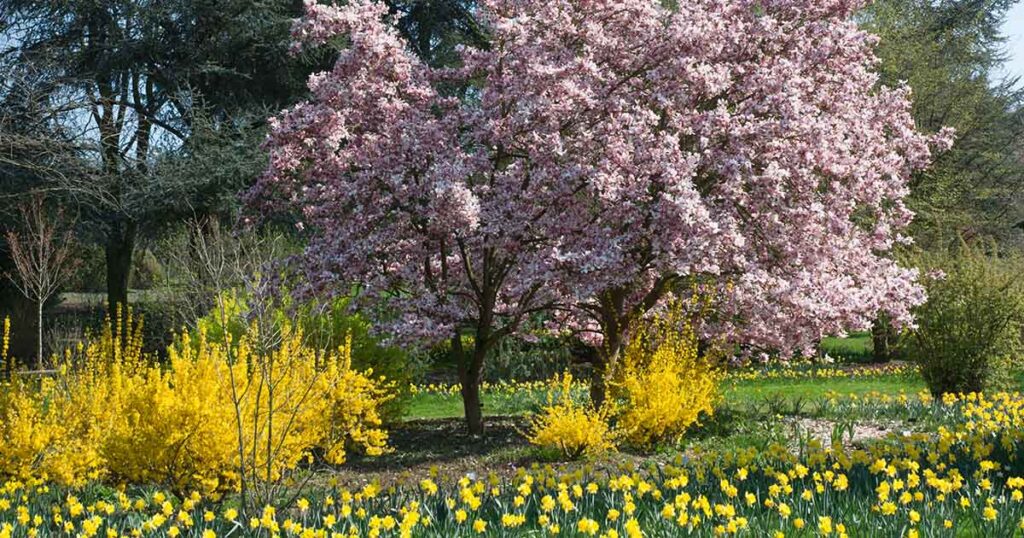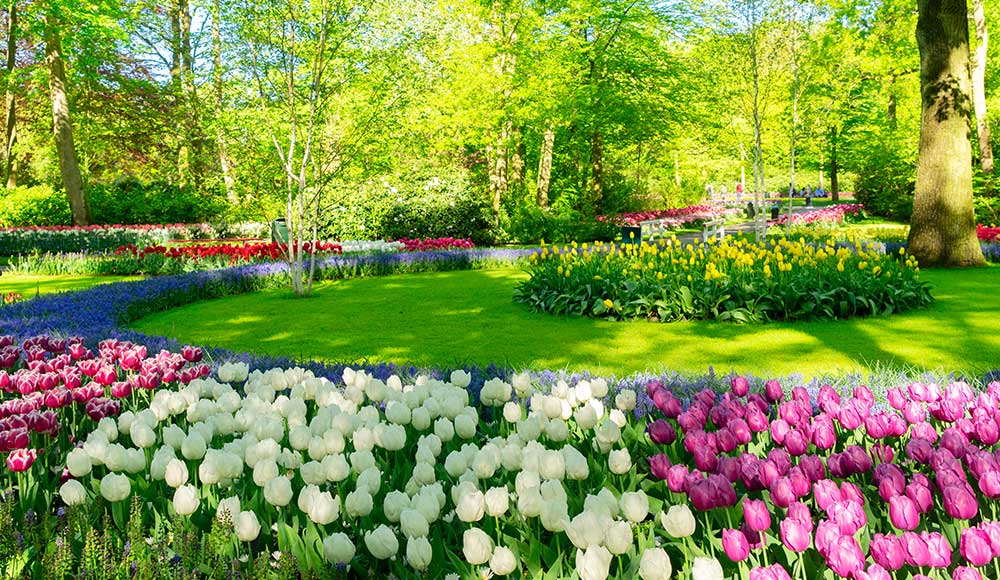Early-Blooming Spring Flowers

This list of early spring flowers is a good place to start if you’re looking for signs of spring at the park or around the neighborhood, or if you’re trying to decide what to plant in your garden.
Bleeding heart:
The bleeding heart is easily recognizable for its small, pink, heart-shaped blooms and lobed green foliage. These springtime flowers soon lose their blooms and go dormant for the remainder of the year. If you want a more colorful garden, place bleeding hearts among other flowering plants. Several different types of Dicentra and Lamprocapnos spectabilis, both of which belong to the poppy family, are known as bleeding hearts. Native to the temperate forests of eastern Asia and North America, bleeding hearts are cultivated as a garden adornment. Any portion of the plant consumed is likely to cause poisoning. The Asian bleeding heart is a perennial favorite due to its dainty, heart-shaped blooms in shades of pink, red, and white that hang from slender, arching stems that reach a height of around 60 centimeters. L. spectabilis ‘Alba,’ a variant that is pure white, is also available. The shorter eastern, or wild, bleeding heart, which grows in the Allegheny mountain region of eastern North America from April to September, is one example of a wild Dicentra species with deeply cut compound leaves that are larger than those of the cultivated variety of Dicentra. Several types of gardening are of importance in the Pacific, or western, bleeding heart of mountain woodlands, which extends from California to British Columbia. The eastern half of North America is filled with fields of Dutchman’s breeches.
Creeping phlox:
Panicles, or clusters of flowers with many stems, are characteristic of the genus Phlox, which includes both annuals and perennials in the family Polemoniaceae. These fragrant, star-shaped blooms can be found all over North America. Due to their spreading nature, they work great in rock gardens and as ground cover. There is a distinct difference between the flowering times of creeping phlox (early spring to early summer) and garden phlox (late summer to early fall). Summer phlox, sometimes known as fall phlox, may grow to heights of more than 1.5 meters (five feet) thanks to its straight, stiff stems, which bear enormous, flat, fragrant flower heads in shades of reddish purple to white. Optimal conditions for growth include wet, nutrient-dense soils. The typical height of an annual phlox plant is 45 cm (1.5 feet), and its flowers are a rosy purple color. Many hybrids with bicolored, star-shaped petals have been developed from this species. A spring-blooming forest perennial, blue phlox can reach a height of 45 centimeters (1.5 feet) and has clusters of either blue or white flowers. In the highland forests and prairies of central North America, the perennial phlox grows to a similar height and features reddish-purple flowers on hairy plants in the summer. Native to sandy soil and rocky ledges in eastern North America, moss pink, also known as creeping phlox, forms a low evergreen mat covered in blue, purple, pink, or white massed blossoms in early spring. Grown as a perennial in gardens, moss pink creeps along the surface of the ground and spreads out into tangled clusters of stems and leaves.
Crocus:
The Iridaceae family includes the perennial flowering plants known as crocuses. Crocus flowers, which are planted in the fall by gardeners, blossom before the end of winter, sometimes before the snow has melted. These plants reach a maximum height of two to five inches and feature grass-like leaves and fragrant, colorful blossoms. In ideal conditions, crocus corms (bulbs) will produce new crocus plants the next year. “Purple Charm” When looking for a low-maintenance ground cover for a rock garden, perennial border, bulb garden, or slope, creeping phlox is a popular pick. This butterfly’s favorite blooms for four to six weeks in the mid-spring garden and is resistant to deer and salt. This natural ground cover is a simple way to bring color and evergreen leaves to your garden in the spring. It reaches a height of just 4 to 6 inches and spreads to a width of 12 to 18 inches, forming a dense moss-like mat. It is not picky, needing only average soil with adequate drainage in a sunny location, and it is a water-efficient perennial that will naturalize and spread, filling up empty patches, once it gets going. Shear it back once the petals have faded to encourage new growth and more blooms the next year. This carpet of needlelike foliage is resistant to extremes in temperature.
Read More: Online Delivery White Rose In Bangalore
Daffodils:

Daffodils are a robust and colorful option for spring gardens and bouquets. Colorful flowers of the Narcissus genus return year after year and “naturalize,” or spread in an area to give it a more natural appearance, in USDA hardiness zones 3 through 8. Daffodils are a beautiful early bloomer for your flowerbed and a bulb plant that blooms in the spring. Daffodils We will have a basic grasp of the poet’s critical analysis after reading this. The poet did not create this poetry from thin air. The idea came from his mental imagery. In “I roamed as a lonely cloud,” the poet describes his feelings of isolation. The loss of a close family member, his brother, was the root cause of his feelings of isolation. A group of golden daffodils waves in the wind as he walks through a field next to the lake. In addition, there were fewer contiguous areas and more spots or dispersion. There must have been millions of them swaying in the air. In addition, the shore was covered in a never-ending sea of dancing, blinking flowers. Along with the flowers, the shimmering lake waves danced. Elegantly, the daffodils drew a path in the water. The poet continues by comparing the golden daffodils to the stars in the Milky Way galaxy because of the way they sparkle and stretch out in an infinite line. The flowers are meant to evoke the celestial beauty of stars. The poet was overjoyed to see so many daffodils in one place, as this was a first for him. Flowers were good company, as he saw them as a happy and cheerful companions. In addition, he continues resetting that lovely scene. He was unable to tear his gaze away from the daffodils’ beauty. But he did not realize the good fortune that this scene would bring him. From that moment on, the sight of the daffodils would always lift his spirits and comfort him whenever he was feeling down. As a result, he feels an overwhelming sense of joy and breaks out into a jig alongside the daffodils.
The story’s main thrust is uncomplicated. There’s a scene where the poet is out and about and comes across a lakeside field of daffodils. When he is lonely, bored, or experiencing restlessness, remembering the daffodils brings him comfort and relief. In addition, the poem’s fundamental genius resides in the reverse personification of its introductory stanzas; the daffodils “flash upon the interior sight,” which is “the ecstasy of isolation,” is a psychologically astute description of the unexpected occurrence of a recollection.
Forsythia:
Forsythia, scientifically known as Forsythia Vahl, is a flowering shrub that belongs to the Oleaceae family. The golden bells are a type of deciduous flowering shrub that blooms in the early spring and gets its common name from the clusters of vivid yellow flowers that grow along the length of the arching branches. Forsythia is a member of the Oleaceae, or olive family, which consists of about 24 living genera and about 600 different species of mesophytic shrubs, trees, and sometimes vines. Members of this family are either string climbers or scramblers when they are shrubs. Those belonging to this family have leaves that are either opposite or alternate, and they may be simple or compound (pinnate or ternate), but they never have a stipule. Whorled or alternating configurations are unusual. Pinnate veins run the length of the lamina, and the margin might be serrate, dentate, or whole. Both deciduous and evergreen varieties exist, with the former being more common in temperate and tropical zones and the latter in colder locations. Bisexual and actinomorphic, the blooms of Oleaceae species typically appear in panicles or racemes and have a pleasant scent. Both the optional calyx and the corolla have four lobes and are synsepalous. Two stamens are inserted into the perigynous zone of the androecium, which occurs between the lobes. Two lobes make up each stigma. It is a complex pistil with two carpels that makes up the gynoecium. A pair of axillary ovules are housed in each of the ovary’s two locules, making the ovary a superior reproductive structure. It is not uncommon for a nectary disc to encircle the ovarian base. In most cases, the plants are hermaphrodites, but in others, they might be polygamonecious. Any of the deciduous shrubs in the genus Forsythia can be referred to by the common name “forsythia.” One to three meters (three to nine feet) tall, and very occasionally up to six meters (18 feet) tall, these plants have rough gray-brown bark. The length of the leaves can be anything from one to four inches (two to ten cm) or even up to fifteen centimeters (six inches) in extreme cases. The leaves are opposite, typically simple but sometimes trifoliate with a basal pair of tiny leaflets (six inches). It has a serrated or whole margin. In most cases, the blooms appear before the leaves do, in the early spring. Their corollas are bright yellow and strongly lobed into four lobes, and their petals are united at the very bottom. They rely on insects to spread their pollen. Fruits are dry capsules that contain numerous seeds with wing membranes. William Forsyth, born in 1804, is honored as the namesake of the forsythia flower since he was a founding member of the Horticultural Society of London, which today is known as the Royal Horticultural Society. King George II employed William Forsyth as a gardener at Kensignton and St. James’s Places after he had worked as a gardener for the Duke of Northumberland at Syon House and as the Curator of Chelsea Physic Garden. Gardens have Popularly grown for their early-blooming, bell-shaped, yellow flowers, which often open before the leaves appear, Forsythia is the genus and common name for a taxon of deciduous shrubs in the flowering plant family Oleaceae (olive family). The tiny genus Forsythia has roughly 11 species, with the majority hailing from eastern Asia and the lone European species being found in southeastern Europe. However, there are also numerous hybrids and cultivars, many of which are used as decorative plants.
Get More: Online Delivery Yellow Rose in Bangalore

Glory-of-the-snow:
Star-shaped, violet to light blue blooms tops the six-inch stalks of the Glory-of-the-Snow plant. This plant prefers slightly acidic soil and partial shade to full sun. In USDA hardiness zones 3–8, glory-of-the-snow blooms independently before the final snowmelt.
Hyacinth:
Spring hyacinths are fragrant and lovely flowers to plant in your garden. It is not difficult to get started growing hyacinths, and many types are even resistant to animals (albeit harmful to pets). Hyacinths can be grown to improve the look of your garden and fill your yard with a heady floral aroma when they bloom. There is an early spring form of hyacinth called grape hyacinth that stands out for its clusters of deep blue, grape-like blossoms that grow on thin green stalks.
Lenten rose:
With a maximum height of twenty-four inches, the Lenten rose (Helleborus orientalis) towers over other springtime blooms in terms of visibility. The flower colors are soft and varied, including pink, purple, and yellow. In addition to their early spring bloom, Lenten roses are a generous garden addition because they may be enjoyed for weeks into late spring. They thrive in shady conditions with sufficient of water and can tolerate late-fall snowfall. Despite its common name, the Lenten Rose is not a member of the rose family but rather the buttercup family as a member of the hellebore species. The flower buds are what give this plant its common name of “rose.” This plant’s blossom has five petals and is surrounded by a ring of tiny cup-shaped pods. The Lenten rose is unique among roses in that it retains its sepals until early spring when it is nearly done flowering. The clusters of flowers, which can be any color, including red, green, yellow, pink, purple, blue, lavender, or white, look stunning against the plant’s evergreen leaves.
The blue flowers of the Siberian squill (Siberica scilla) bulb plant can take on the appearance of stars or bells. Once established, these plants can be left to flourish in their natural environment. Adding fertilizer at the start of the growing season can help them bloom more profusely.
Snowdrops:
Flowers of the genus Galanthus (commonly known as snowdrops) are among the first springtime bloomers; they are so early that they may even be seen emerging through the snow in late December. The tallest these plants and blooms get is around six inches. The drooping white blossoms have a beautiful bell shape. These early spring flower bulbs are suitable for both outdoor gardens and indoor containers.
Tulips:
Tulips, or blooms of the genus Tulipa, are long-lasting members of the lily family. The enormous, showy cup-shaped flowers come in a rainbow of hues, and they bloom in the spring from bulbs. Technically speaking, tulips are perennials, although many kinds have trouble continuing to bloom after the first year. For this reason, most gardeners treat them as annuals and replace the bulbs each year. Orange, red, white, pink, and yellow are just some of the early-blooming color palettes available in single-flowered tulip varieties like ‘Apricot Beauty’ and ‘Candy Prince.

